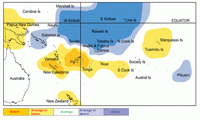Tropical rainfall outlook: December 2006 to February 2007

Rainfall forecasts for the Pacifi c region clearly exhibit El Niño patterns for the coming three months, December 2006 to February 2007.
Enhanced convection is expected in the equatorial region of Western and Eastern Kiribati, Tuvalu, and Tokelau where rainfall is forecast to be above average. Enhanced convection is also expected from the Solomon Islands eastwards to Northern Cook Islands including Wallis and Futuna, and Samoa, and Pitcairn Island.
Suppressed convection is expected from Papua New Guinea eastwards to the Marquesas Islands including, Vanuatu, Tonga, Niue, the Southern Cook Islands and Tuamotu Islands, where rainfall is forecast to be near or below average. Below average rainfall is expected over New Caledonia and Fiji.
Society and Austral Islands are expected to experience near average rainfall.
| Island group | Rainfall outlook | Outlook confidence |
|---|---|---|
| Western Kiribati | 20:30:50 (Above) | Moderate – high |
| Eastern Kiribati | 20:30:50 (Above) | Moderate – high |
| Tuvalu | 20:30:50 (Above) | Moderate – high |
| Tokelau | 20:30:50 (Above) | Moderate – high |
| Solomon Islands | 20:40:40 (Near average or above) | Moderate – high |
| Wallis and Futuna | 20:40:40 (Near average or above) | Moderate – high |
| Samoa | 20:40:40 (Near average or above) | Moderate |
| Northern Cook Islands | 20:40:40 (Near average or above) | Moderate |
| Pitcairn Island | 20:40:40 (Near average or above) | Moderate – high |
| Society Islands | 25:45:30 (Near average) | Moderate – high |
| Austral Islands | 25:45:30 (Near average) | Moderate – high |
| Papua New Guinea | 40:40:20 (Near average or below) | Moderate – high |
| Vanuatu | 50:30:20 (Near average or below) | Moderate – high |
| Tonga | 40:40:20 (Near average or below) | Moderate – high |
| Niue | 40:40:20 (Near average or below) | Moderate |
| Southern Cook Islands | 40:40:20 (Near average or below) | Moderate |
| Tuamotu Islands | 40:40:20 (Near average or below) | Moderate |
| Marquesas Islands | 40:40:20 (Near average or below) | Moderate |
| New Caledonia | 45:35:20 (Below) | Moderate |
| Fiji | 50:30:20 (Below) | Moderate – high |
NOTE: Rainfall estimates for Pacific Islands for the next three months are given in the table. The tercile probabilities (e.g., 20:30:50) are derived from the interpretation of several global climate models. They correspond to the odds of the observed rainfall being in the lowest (driest) one third of the rainfall distribution, the middle one third, or the highest (wettest) one third of the distribution. On the long-term average, rainfall is equally likely (33% chance) in any tercile.
Forecast validation: September to November 2006
Suppressed convection with average or below average rainfall was expected over New Caledonia, and also the Marquesas Islands. Enhanced convection with near or above average rainfall was expected to extend from Western Kiribati to Pitcairn Island, including the Solomon Islands, Samoa, the Southern Cook Islands, the Society, and the Austral Islands. Near average rainfall was expected elsewhere in the region.
A large region of enhanced convection and/or above average rainfall affected the region between the Solomon Islands and the Dateline, including Vanuatu and Western Kiribati. Convection was also enhanced, with above average rainfall, in the Tuamotu Islands. Rainfall tended below average from New Caledonia to Niue, including Tonga. Seasonal rainfall anomalies turned out as forecast for many Islands, but was lower than expected in Niue. The ‘hit’ rate for the September-November 2006 outlook was just over 70%.
Tropical cyclones
Two named tropical cyclones have occurred so far this season. ‘Xavier’ was the first occurrence over 22-25 October, followed by ‘Yani’ over 22-25 November. ‘Yani’ had estimated maximum sustained wind speeds of 120 km/h, which is category 1 on the Saffi r-Simpson scale. An unnamed tropical storm occurred over 30 November – 1 December with estimated maximum sustained wind speeds of 65 km/h. All three of these events occurred over the seas between the Solomon Islands and Fiji.
The characteristics of the El Niño conditions presently affecting in the Pacific are giving a higher confidence in the tropical cyclone forecast for the Southwest Pacific produced in October’s issue of the ICU, in that above average numbers of tropical cyclones are likely to be seen in several parts of the South Pacific near and east of the Date Line this season, with a normal rate of occurrence in Islands west of the Date Line.
Future issues of the ICU will provide updates on information relating to further occurrences of tropical cyclones in the region.
